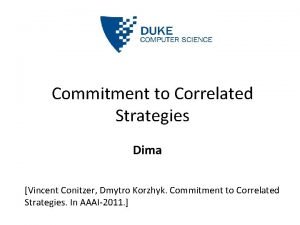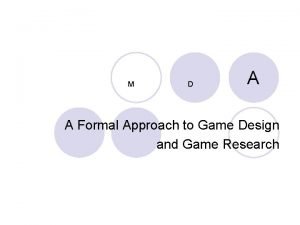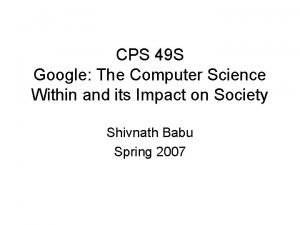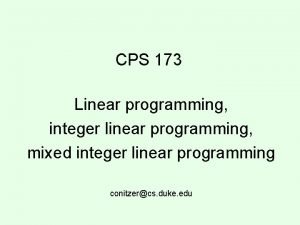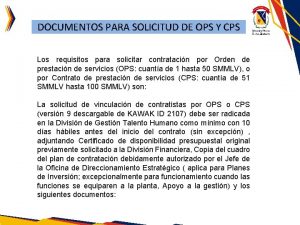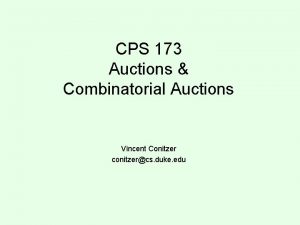CPS 296 3 Game Theory Vincent Conitzer conitzercs


















![Minimax theorem [von Neumann 1927] • In general, which one is bigger: – maxσi Minimax theorem [von Neumann 1927] • In general, which one is bigger: – maxσi](https://slidetodoc.com/presentation_image_h/8e17719a0618b9af44e0bbfbc5165423/image-19.jpg)

![Nash equilibrium [Nash 50] • A vector of strategies (one for each player) is Nash equilibrium [Nash 50] • A vector of strategies (one for each player) is](https://slidetodoc.com/presentation_image_h/8e17719a0618b9af44e0bbfbc5165423/image-21.jpg)

























- Slides: 46

CPS 296. 3 Game Theory Vincent Conitzer conitzer@cs. duke. edu

Risk attitudes • Which would you prefer? – A lottery ticket that pays out $10 with probability. 5 and $0 otherwise, or – A lottery ticket that pays out $3 with probability 1 • How about: – A lottery ticket that pays out $100, 000 with probability. 5 and $0 otherwise, or – A lottery ticket that pays out $30, 000 with probability 1 • Usually, people do not simply go by expected value • An agent is risk-neutral if she only cares about the expected value of the lottery ticket • An agent is risk-averse if she always prefers the expected value of the lottery ticket to the lottery ticket – Most people are like this • An agent is risk-seeking if she always prefers the lottery ticket to the expected value of the lottery ticket

Decreasing marginal utility • Typically, at some point, having an extra dollar does not make people much happier (decreasing marginal utility) utility buy a nicer car (utility = 3) buy a car (utility = 2) buy a bike (utility = 1) $200 $1500 $5000 money

Maximizing expected utility buy a nicer car (utility = 3) buy a car (utility = 2) buy a bike (utility = 1) $200 $1500 $5000 money • Lottery 1: get $1500 with probability 1 – gives expected utility 2 • Lottery 2: get $5000 with probability. 4, $200 otherwise – gives expected utility. 4*3 +. 6*1 = 1. 8 – (expected amount of money =. 4*$5000 +. 6*$200 = $2120 > $1500) • So: maximizing expected utility is consistent with risk aversion

Different possible risk attitudes under expected utility maximization utility • • money Green has decreasing marginal utility → risk-averse Blue has constant marginal utility → risk-neutral Red has increasing marginal utility → risk-seeking Grey’s marginal utility is sometimes increasing, sometimes decreasing → neither risk-averse (everywhere) nor risk-seeking (everywhere)

Normal-form games

Rock-paper-scissors Column player aka. player 2 (simultaneously) chooses a column 0, 0 -1, 1 1, -1 Row player aka. player 1 chooses a row A row or column is called an action or (pure) strategy 1, -1 0, 0 -1, 1 1, -1 0, 0 Row player’s utility is always listed first, column player’s second Zero-sum game: the utilities in each entry sum to 0 (or a constant) Three-player game would be a 3 D table with 3 utilities per entry, etc.

“Chicken” • Two players drive cars towards each other • If one player goes straight, that player wins • If both go straight, they both die S D D S S 0, 0 -1, 1 1, -1 -5, -5 not zero-sum

Rock-paper-scissors – Seinfeld variant MICKEY: All right, rock beats paper! (Mickey smacks Kramer's hand for losing) KRAMER: I thought paper covered rock. MICKEY: Nah, rock flies right through paper. KRAMER: What beats rock? MICKEY: (looks at hand) Nothing beats rock. 0, 0 1, -1 -1, 1 0, 0 -1, 1 1, -1 0, 0

Dominance • Player i’s strategy si strictly dominates si’ if – for any s-i, ui(si , s-i) > ui(si’, s-i) • si weakly dominates si’ if – for any s-i, ui(si , s-i) ≥ ui(si’, s-i); and – for some s-i, ui(si , s-i) > ui(si’, s-i) strict dominance weak dominance -i = “the player(s) other than i” 0, 0 1, -1 -1, 1 0, 0 -1, 1 1, -1 0, 0

Prisoner’s Dilemma • Pair of criminals has been caught • District attorney has evidence to convict them of a minor crime (1 year in jail); knows that they committed a major crime together (3 years in jail) but cannot prove it • Offers them a deal: – If both confess to the major crime, they each get a 1 year reduction – If only one confesses, that one gets 3 years reduction confess don’t confess -2, -2 0, -3 -3, 0 -1, -1

“Should I buy an SUV? ” accident cost purchasing cost: 5 cost: 3 cost: 5 cost: 8 cost: 2 cost: 5 -10, -10 -7, -11, -7 -8, -8

Mixed strategies • Mixed strategy for player i = probability distribution over player i’s (pure) strategies • E. g. 1/3 , 1/3 • Example of dominance by a mixed strategy: 1/2 3, 0 0, 0 1/2 0, 0 3, 0 1, 0

Iterated dominance • Iterated dominance: remove (strictly/weakly) dominated strategy, repeat • Iterated strict dominance on Seinfeld’s RPS: 0, 0 1, -1 -1, 1 0, 0 -1, 1 1, -1 0, 0 1, -1 -1, 1 0, 0

Zero-sum games revisited • Recall: in a zero-sum game, payoffs in each entry sum to zero – … or to a constant: recall that we can subtract a constant from anyone’s utility function without affecting their behavior • What the one player gains, the other player loses 0, 0 -1, 1 1, -1 0, 0

Best-response strategies • Suppose you know your opponent’s mixed strategy – E. g. your opponent plays rock 50% of the time and scissors 50% • • • What is the best strategy for you to play? Rock gives. 5*0 +. 5*1 =. 5 Paper gives. 5*1 +. 5*(-1) = 0 Scissors gives. 5*(-1) +. 5*0 = -. 5 So the best response to this opponent strategy is to (always) play rock • There is always some pure strategy that is a best response – Suppose you have a mixed strategy that is a best response; then every one of the pure strategies that mixed strategy places positive probability on must also be a best response

Minimax (minmax, maxmin) strategies • Let us consider 2 -player zero-sum games • Suppose that your opponent can see into your head and thus knows your mixed strategy • But your opponent does not know your random bits – E. g. your opponent knows that you play rock 50% of the time and scissors 50% of the time, but not which one you will actually happen to play this time – I. e. your opponent best-responds to your mixed strategy • What is the best that you (i) can do against such a powerful opponent (-i)? • maxσi mins-i ui(σi, s-i) (= - minσi maxs-i u-i(σi, s-i)) – Here σi is a mixed strategy, s-i is a pure strategy, and utility functions are extended to mixed strategies by taking the expectation of the utility over pure strategies

Computing a minimax strategy for rock-paper-scissors • Need to set: prock, ppaper, pscissors • Utility for other player of playing rock is pscissors - ppaper • Utility for other player of playing paper is prock - pscissors • Utility for other player of playing scissors is ppaper – prock • So, we want to minimize max{pscissors - ppaper, prock - pscissors, ppaper – prock} • Minimax strategy: prock = ppaper = pscissors = 1/3
![Minimax theorem von Neumann 1927 In general which one is bigger maxσi Minimax theorem [von Neumann 1927] • In general, which one is bigger: – maxσi](https://slidetodoc.com/presentation_image_h/8e17719a0618b9af44e0bbfbc5165423/image-19.jpg)
Minimax theorem [von Neumann 1927] • In general, which one is bigger: – maxσi mins-i ui(σi, s-i) (-i gets to look inside i’s head), or – minσ-i maxsi ui(si, σ-i) (i gets to look inside –i’s head)? • Answer: they are always the same!!! – This quantity is called the value of the game (to player i) • Closely related to linear programming duality • Summarizing: if you can look into the other player’s head (but the other player anticipates that), you will do no better than if the roles were reversed • Only true if we allow for mixed strategies – If you know the other player’s pure strategy in rock-paperscissors, you will always win

General-sum games • You could still play a minimax strategy in generalsum games – I. e. pretend that the opponent is only trying to hurt you • But this is not rational: 0, 0 1, 0 3, 1 2, 1 • If Column was trying to hurt Row, Column would play Left, so Row should play Down • In reality, Column will play Right (strictly dominant), so Row should play Up • Is there a better generalization of minimax strategies in zerosum games to general-sum games?
![Nash equilibrium Nash 50 A vector of strategies one for each player is Nash equilibrium [Nash 50] • A vector of strategies (one for each player) is](https://slidetodoc.com/presentation_image_h/8e17719a0618b9af44e0bbfbc5165423/image-21.jpg)
Nash equilibrium [Nash 50] • A vector of strategies (one for each player) is called a strategy profile • A strategy profile (σ1, σ2 , …, σn) is a Nash equilibrium if each σi is a best response to σ-i – That is, for any i, for any σi’, ui(σi, σ-i) ≥ ui(σi’, σ-i) • Note that this does not say anything about multiple agents changing their strategies at the same time • In any (finite) game, at least one Nash equilibrium (possibly using mixed strategies) exists [Nash 50] • (Note - singular: equilibrium, plural: equilibria)

Nash equilibria of “chicken” D S S D D S 0, 0 -1, 1 1, -1 -5, -5 • (D, S) and (S, D) are Nash equilibria – They are pure-strategy Nash equilibria: nobody randomizes – They are also strict Nash equilibria: changing your strategy will make you strictly worse off • No other pure-strategy Nash equilibria

Nash equilibria of “chicken”… D D S S 0, 0 -1, 1 1, -1 -5, -5 • Is there a Nash equilibrium that uses mixed strategies? Say, where player 1 uses a mixed strategy? • Recall: if a mixed strategy is a best response, then all of the pure strategies that it randomizes over must also be best responses • So we need to make player 1 indifferent between D and S • Player 1’s utility for playing D = -pc. S • Player 1’s utility for playing S = pc. D - 5 pc. S = 1 - 6 pc. S • So we need -pc. S = 1 - 6 pc. S which means pc. S = 1/5 • Then, player 2 needs to be indifferent as well • Mixed-strategy Nash equilibrium: ((4/5 D, 1/5 S), (4/5 D, 1/5 S)) – People may die! Expected utility -1/5 for each player

The presentation game Presenter Pay attention (A) Audience Do not pay attention (NA) Put effort into presentation (E) Do not put effort into presentation (NE) 4, 4 0, -2 -16, -14 0, 0 • Pure-strategy Nash equilibria: (A, E), (NA, NE) • Mixed-strategy Nash equilibrium: ((1/10 A, 9/10 NA), (4/5 E, 1/5 NE)) – Utility 0 for audience, -14/10 for presenter – Can see that some equilibria are strictly better for both players than other equilibria, i. e. some equilibria Pareto-dominate other equilibria

The “equilibrium selection problem” • You are about to play a game that you have never played before with a person that you have never met • According to which equilibrium should you play? • Possible answers: – Equilibrium that maximizes the sum of utilities (social welfare) – Or, at least not a Pareto-dominated equilibrium – So-called focal equilibria • “Meet in Paris” game - you and a friend were supposed to meet in Paris at noon on Sunday, but you forgot to discuss where and you cannot communicate. All you care about is meeting your friend. Where will you go? – Equilibrium that is the convergence point of some learning process – An equilibrium that is easy to compute –… • Equilibrium selection is a difficult problem

Some properties of Nash equilibria • If you can eliminate a strategy using strict dominance or even iterated strict dominance, it will not occur (i. e. it will be played with probability 0) in every Nash equilibrium – Weakly dominated strategies may still be played in some Nash equilibrium • In 2 -player zero-sum games, a profile is a Nash equilibrium if and only if both players play minimax strategies – Hence, in such games, if (σ1, σ2) and (σ1’, σ2’) are Nash equilibria, then so are (σ1, σ2’) and (σ1’, σ2) • No equilibrium selection problem here!

Extensive-form games

Extensive-form games with perfect information Player 1 Player 2 2, 4 Player 2 5, 3 Leaves of the tree show player 1’s utility first, then player 2’s utility 3, 2 1, 0 • Players do not move simultaneously • When moving, each player is aware of all the previous moves (perfect information) • A (pure) strategy for player i is a mapping from player i’s nodes to Player 1 actions 0, 1

Backward induction Player 1 Player 2 • When we know what will happen at each of a node’s children, we can decide the best action for the player who is moving at that node Player 1 2, 4 5, 3 3, 2 1, 0 0, 1

A limitation of backward induction • If there are ties, then how they are broken affects what happens higher up in the tree • Multiple equilibria… Player 1 . 12345 . 87655 Player 2 1/2 3, 2 2, 3 4, 1 1/2 0, 1

Conversion from extensive to normal form Player 1 LR = Left if 1 moves Left, Right if 1 moves Right; etc. LL Player 2 L R 3, 2 2, 3 4, 1 0, 1 LR RL RR 3, 2 2, 3 4, 1 0, 1 • Nash equilibria of this normal-form game include (R, LL), (R, RL), (L, RR) + infinitely many mixed-strategy equilibria • In general, normal form can have exponentially many strategies

Converting the first game to normal form LL Player 1 Player 2 5, 3 RL RR LL 2, 4 Player 2 2, 4 LR 3, 2 1, 0 2, 4 5, 3 LR 2, 4 5, 3 RL 3, 2 1, 0 RR 3, 2 0, 1 • Pure-strategy Nash equilibria Player 1 of this game are (LL, LR), (LR, LR), (RL, LL), (RR, LL) • But the only backward induction solution is (RL, LL) • Normal form fails to capture some of the structure of the 0, 1 extensive form

Subgame perfect equilibrium • Each node in a (perfect-information) game tree, together with the remainder of the game after that node is reached, is called a subgame • A strategy profile is a subgame perfect equilibrium if it is an equilibrium LL LR RL RR for every subgame LL 2, 4 5, 3 Player 1 Player 2 LR 2, 4 5, 3 RL 3, 2 1, 0 RR 3, 2 0, 1 Player 2 *L *R *L 3, 2 1, 0 *R 3, 2 0, 1 2, 4 5, 3 ** *L 1, 0 *R 0, 1 Player 1 3, 2 1, 0 • (RR, LL) and (LR, LR) are not subgame perfect equilibria because (*R, **) is not an equilibrium • (LL, LR) is not subgame perfect because (*L, *R) is not an equilibrium 0, 1 • *R is not a credible threat

Imperfect information • Dotted lines indicate that a player cannot distinguish between two (or more) states – A set of states that are connected by dotted lines is called an information set • Reflected in the normal-form representation Player 1 L L Player 2 0, 0 Player 2 -1, 1 1, -1 R 0, 0 1, 1 R -1, 1 -5, -5 • Any normal-form game can be transformed into an imperfect-information extensive-form game this way

A poker-like game “nature” 1 gets King player 1 bet stay player 2 call fold 2 1 2/3 cc 1/3 bb cf 1/3 fc ff 0, 0 1, -1 2/3 bs . 5, -. 5 1. 5, -1. 5 0, 0 1, -1 sb -. 5, . 5 1, -1 ss 0, 0 1, -1 1 gets Queen call 1 fold call fold 1 1 1 -2 -1

Repeated games • In a (typical) repeated game, – – players play a normal-form game (aka. the stage game), then they see what happened (and get the utilities), then they play again, etc. • Can be repeated finitely or infinitely many times • Really, an extensive form game – Would like to find subgame-perfect equilibria • One subgame-perfect equilibrium: keep repeating some Nash equilibrium of the stage game • But are there other equilibria?

Finitely repeated Prisoner’s Dilemma • Two players play the Prisoner’s Dilemma k times cooperate defect cooperate 2, 2 0, 3 defect 3, 0 1, 1 • In the last round, it is dominant to defect • Hence, in the second-to-last round, there is no way to influence what will happen • So, it is optimal to defect in this round as well • Etc. • So the only equilibrium is to always defect

Modified Prisoner’s Dilemma • Suppose the following game is played twice cooperate defect 1 defect 2 cooperate 5, 5 0, 6 defect 1 6, 0 4, 4 1, 1 defect 2 6, 0 1, 1 2, 2 • Consider the following strategy: – In the first round, cooperate; – In the second round, if someone defected in the first round, play defect 2; otherwise, play defect 1 • If both players play this, is that a subgame perfect equilibrium?

Another modified Prisoner’s Dilemma • Suppose the following game is played twice cooperate defect crazy 5, 5 0, 6 1, 0 defect 6, 0 4, 4 1, 0 crazy 0, 1 0, 0 cooperate • What are the subgame perfect equilibria? • Consider the following strategy: – In the first round, cooperate; – In the second round, if someone played defect or crazy in the first round, play crazy; otherwise, play defect • Is this a Nash equilibrium (not subgame perfect)?

Infinitely repeated games • First problem: are we just going to add up the utilities over infinitely many rounds? – Everyone gets infinity! • (Limit of) average payoff: limn→∞Σ 1≤t≤nu(t)/n – Limit may not exist… • Discounted payoff: Σtδtu(t) for some δ < 1

Infinitely repeated Prisoner’s Dilemma cooperate defect cooperate 2, 2 0, 3 defect 3, 0 1, 1 • Tit-for-tat strategy: – Cooperate the first round, – In every later round, do the same thing as the other player did in the previous round • Is both players playing this a Nash/subgame-perfect equilibrium? Does it depend on δ? • Trigger strategy: – Cooperate as long as everyone cooperates – Once a player defects, defect forever • Is both players playing this a subgame-perfect equilibrium? • What about one player playing tit-for-tat and the other playing trigger?

Folk theorem(s) • Can we somehow characterize the equilibria of infinitely repeated games? – Subgame perfect or not? – Averaged utilities or discounted? • Easiest case: averaged utilities, no subgame perfection • We will characterize what (averaged) utilities (u 1, u 2, …, un) the agents can get in equilibrium • The utilities must be feasible: there must be outcomes of the game such that the agents, on average, get these utilities • They must also be enforceable: deviation should lead to punishment that outweighs the benefits of deviation • Folk theorem: a utility vector can be realized by some Nash equilibrium if and only if it is both feasible and enforceable

Feasibility 2, 2 3, 0 0, 3 1, 1 • The utility vector (2, 2) is feasible because it is one of the outcomes of the game • The utility vector (1, 2. 5) is also feasible, because the agents could alternate between (2, 2) and (0, 3) • What about (. 5, 2. 75)? • What about (3, 0. 1)? • In general, convex combinations of the outcomes of the game are feasible

Enforceability 2, 2 0, 3 3, 0 1, 1 • A utility for an agent is not enforceable if the agent can guarantee herself a higher utility • E. g. a utility of. 5 for player 1 is not enforceable, because she can guarantee herself a utility of 1 by defecting • A utility of 1. 2 for player 1 is enforceable, because player 2 can guarantee player 1 a utility of at most 1 by defecting • What is the relationship to minimax strategies & values?

Stochastic games • • • A stochastic game has multiple states that it can be in Each state corresponds to a normal-form game After a round, the game randomly transitions to another state Transition probabilities depend on state and actions taken Typically utilities are discounted over time 1, 1 1, 0 0, 1 0, 0 . 2. 5 2, 2 0, 3 3, 0 1, 1 . 4. 3. 6 1, 0 0, 1 1, 0 • 1 -state stochastic game = (infinitely) repeated game • 1 -agent stochastic game = Markov Decision Process (MDP)

Stationary strategies • A stationary strategy specifies a mixed strategy for each state – Strategy does not depend on history – E. g. in a repeated game, stationary strategy = always playing the same mixed strategy • An equilibrium in stationary strategies always exists [Fink 64] • Each player will have a value for being in each state
 Cps 173
Cps 173 Conitzer
Conitzer Conitzer
Conitzer Conitzer
Conitzer Correlated equilibrium
Correlated equilibrium Pirate grid game
Pirate grid game Game lab game theory
Game lab game theory Liar game game theory
Liar game game theory Liar game game theory
Liar game game theory Wac 296-155-305
Wac 296-155-305 Wac 296-800-160
Wac 296-800-160 Wac 296 305
Wac 296 305 Nnpj-296
Nnpj-296 Sos mihai bravu 296
Sos mihai bravu 296 Wac 296 305
Wac 296 305 E-296
E-296 When placing solid web members for beams/columns
When placing solid web members for beams/columns Wac 296-307
Wac 296-307 Cs 296
Cs 296 Game theory and graph theory
Game theory and graph theory The farming game board game
The farming game board game A formal approach to game design and game research
A formal approach to game design and game research Cps algebra exit exam
Cps algebra exit exam Cps in project management
Cps in project management Ipums cps
Ipums cps Cps freshman connection
Cps freshman connection Cps special investigator
Cps special investigator Cps molve
Cps molve Continuation-passing style
Continuation-passing style Cps506
Cps506 Cps506
Cps506 Sgoogle slides
Sgoogle slides Cps 173
Cps 173 Cps 1s
Cps 1s Cps 173
Cps 173 Combat propulsion systems
Combat propulsion systems Cps tatou connexion
Cps tatou connexion Cps template
Cps template Cps-naid
Cps-naid Cps
Cps Nielsen cps
Nielsen cps Dmr cps software hytera
Dmr cps software hytera Centor cps
Centor cps Cps ops
Cps ops Cps north west
Cps north west Cps
Cps Cps
Cps




